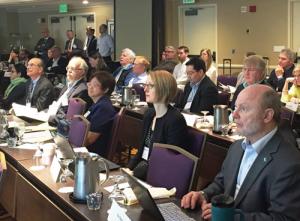Focus on DERs
NARUC would like to thank the U.S. Department of Energy for their continued support of NCEP.
Jan Brinch has over thirty years of experience in the energy field, providing independent analysis and collaborative stakeholder support to public and private institutions on electricity issues, particularly the integration of distributed energy resources onto the grid.
Kerry Worthington has been supporting regulatory utility commissions for six years and has expertise in policy considerations for transmission planning, distributed energy resources integration, and rate design.
At the National Council on Electricity Policy's annual meeting, a diverse group of more than seventy participants from around the country heard examples of planning, operations, and market developments underway and needed for integrating higher levels of distributed energy resources on the distribution grid, and their impacts and intersection points on the transmission network.

They gained insights and lessons learned from state regulators, energy directors, utility managers, technologists, legislators, and consumer advocates who have been involved in recent DER-related distribution and transmission changes. And they shared their own questions, experiences, and research needs as investments in new energy-related technologies, products, and activities are underway along the transmission and distribution parts of the grid.
Particularly lively were discussions about whether DERs can reduce the need for bulk power investments and utility-scale renewable resources. There was a consensus that storage and distributed generation have the potential to reduce the need for transmission services, but great debate ensued about the role of energy efficiency, demand management, and other forms of non-wires alternatives. The potential exists within a transactive energy system for such programs to have an impact, but reliability and value to wholesale customers will certainly influence their full potential role.
The impact of DERs on distribution system operations was well documented through a series of snapshots that highlighted recent experiences across the country. Wind, rooftop solar, demand response, storage, and energy efficiency on the distribution systems in Hawaii, New Jersey, Maine, Missouri, and other states and regions were identified as examples that offered valuable insights, but lingering questions remain as to their value on the transmission system, in particular at the intersection points.
Customer needs and expectations were similarly highlighted during the NCEP annual meeting. As more opportunities for new energy-related technologies, products and activities grow, utility customers often do not know how to access them or remain satisfied with their current cost of service. And of course, speakers and participants addressed the continuing debate about who pays for these new products and services and how fairness is assessed.
 Jan Brinch: NREL’s super computer enables people to go inside the turbulence created by wind turbines and visualize the flow of electricity from distributed generation.
Jan Brinch: NREL’s super computer enables people to go inside the turbulence created by wind turbines and visualize the flow of electricity from distributed generation.
Many new products and services impact planning, operations, and markets along the transmission and distribution grids, affecting customer services and utility grid modernization efforts. Informed and engaged customers rely on state and regional policy-makers to make decisions that affect grid operations and compensation, particularly related to DER on the transmission and distribution systems. The intersection points of these customers and systems are not fully understood, as the technologies and processes are constantly evolving.
Most exciting at the annual meeting were the large number of projects, policies, and programs that were shared by every participant, as well as resources available and questions participants had on the growth of DERs and their impact on the transmission and distribution grids. Early this fall, NCEP will also produce a Compendium of Resources that provides detail and links to these projects, policies, programs, and resources.
This data and information, in addition to the snapshots provided by many expert speakers, is being developed into a State of the States report, to be published by NCEP in late 2018. The report will be of value to NCEP members throughout by the country as they address the modernizing grid, and the intersecting transmission and distribution systems.
In addition to attending the NCEP annual meeting, many NCEP attendees toured the National Renewable Energy Laboratory's virtual Distribution System 3D Visualization Model.
 Kerry Worthington: The National Council on Electricity Policy is the only national stakeholder organization that supports all state-level decision-makers involved in electricity policy.
Kerry Worthington: The National Council on Electricity Policy is the only national stakeholder organization that supports all state-level decision-makers involved in electricity policy.
NREL's super computer enables people to go inside the turbulence created by wind turbines, visualize the flow of electricity from distributed generation to neighboring businesses and homes, and generally visualize and model myriad forms of interactions on an electric grid.
The NREL tour was particularly useful given the discussions about the role of DERs in a transactive energy system and their impacts on transmission and distribution system plans and operations.
The National Council on Electricity Policy is the only national stakeholder organization that supports all state-level decision-makers involved in electricity policy. NCEP's state community includes over fifty jurisdictions, with representatives from utility commissions, air and environmental regulatory agencies, gubernatorial staff and state energy offices, legislators, and consumer advocates.
NCEP is an initiative of the NARUC Center for Partnerships and Innovation, formerly known as the NARUC Research Lab.
NCEP facilitates training and education programs, conferences and seminars, webinars and podcasts, on such topics as transmission siting and pricing policy; valuation of electricity resources across the generation, transmission, and distribution system; and alignment of energy resource development at both the transmission and distribution levels.
For more information, and a complete agenda with links to all presentations given at the annual meeting and workshop, visit the NCEP website at www.electricitypolicy.org.
NCEP serves as a marketplace of ideas on electricity issues in the U.S. EISPC is an activity of NCEP, developing input on Eastern Interconnection issues and analyses. Together, these organizations address important technology, market, environmental, and regulatory issues facing the nation's electric system. Visit www.electricitypolicy.org for more information.




